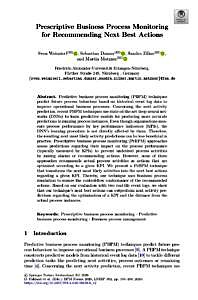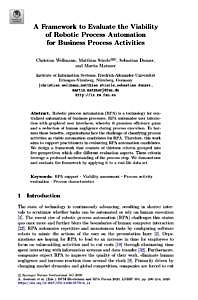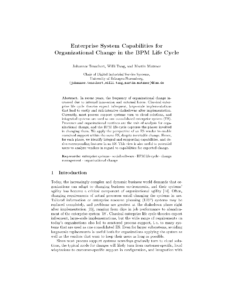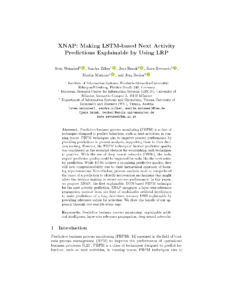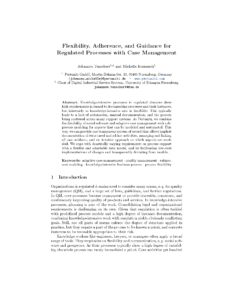Neue Publikationen: BPM 2020
In diesem Jahr war unser Lehrstuhl mit vier Beiträgen auf der 18. International Conference on Business Process Management (BPM) vertreten. Die Konferenz fand vom 13. bis zum 18. September 2020 virtuell in Sevilla statt und ist eine der wichtigsten Konferenzen für Geschäftsprozessmanagement. Herzlichen Glückwunsch an alle Autoren! Sie können die Beiträge über die Bild-Links aufrufen.
Prescriptive Business Process Monitoring for Recommending Next Best Actions
Sven Weinzierl, Sebastian Dunzer, Sandra Zilker, Martin Matzner
Predictive business process monitoring (PBPM) techniques predict future process behaviour based on deep neural networks, which consider historical event log data, in order to improve operational business processes. However, these predictive models are not directly affected by key performance indicators (KPIs) that organisations use to measure processes’ performance, thus, the most likely predicted activity might not be beneficial. At the same time, prescriptive business process monitoring (PrBPM) approaches asses predictions considering their impact on process performance (measured by KPIs), but none of them recommend actual process activities as actions that are optimised according to a given KPI. In this work Sven Weinzierl, Sebastian Dunzer, Sandra Zilker and Martin Matzner present a PrBPM technique that transforms the next most likely activities into the next best actions considering a given KPI.
A Framework to Evaluate the Viability of Robotic Process Automation for Business Process Activities
Christian Wellmann, Matthias Stierle, Sebastian Dunzer, Martin Matzner
In order to automate business processes companies implement robotic process automation technology (RPA), which is also expected to increase productivity gains and reduce human negligence during process execution. However, the challenge is to classify a process as the one that could be used for RPA. To solve this problem Christian Wellmann, Matthias Stierle, Sebastian Dunzer, and Martin Matzner have developed a multi-criteria approach for selecting appropriate RPA automation candidates.
Enterprise System Capabilities for Organizational Change in the BPM Life Cycle
Johannes Tenschert, Willi Tang, Martin Matzner
In recent years, the frequency of organizational change increased due to internal innovation and external forces. Classical enterprise life cycle theories expect infrequent, large-scale implementations that lead to costly and risk-intensive shakedowns after implementation. Currently, most process support systems turn to cloud solutions, and integrated systems are used as one consolidated enterprise system (ES). Processes and organizational routines are the unit of analysis for organizational change, and the BPM life cycle captures the phases involved in changing them. In this paper the authors Johannes Tenschert, Willi Tang, and Martin Matzner, apply the perspective of an ES vendor to enable sustained support within the same ES, despite inevitable change. Hence, for each phase, we identify integral and supporting capabilities, and derive corresponding features in an ES. This view is also useful to potential users to analyze vendors in regard to capabilities for expected change.
XNAP: Making LSTM-based Next Activity Predictions Explainable by Using LRP
Sven Weinzierl, Sandra Zilker, Jens Brunk, Kate Revoredo, Martin Matzner, Jörg Becker
Predictive business process monitoring (PBPM) is a class of techniques designed to predict behaviour, such as next activities, in running traces. PBPM techniques aim to improve process performance by providing predictions to process analysts, supporting them in their decision making. However, the PBPM techniques‘ limited predictive quality was considered as the essential obstacle for establishing such techniques in practice. With the use of deep neural networks (DNNs), the tech-niques‘ predictive quality could be improved for tasks like the next activity prediction. While DNNs achieve a promising predictive quality, they still lack comprehensibility due to their hierarchical approach of learning representations. Nevertheless, process analysts need to comprehend the cause of a prediction to identify intervention mechanisms that might affect the decision making to secure process performance. In this paper, we propose XNAP, the first explainable, DNN-based PBPM technique for the next activity prediction. XNAP integrates a layer-wise relevance propagation method from the field of explainable artificial intelligence to make predictions of a long short-term memory DNN explainable by providing relevance values for activities. In this work Sven Weinzierl, Sandra Zilker, Jens Brunk, Kate Revoredo, Martin Matzner and Jörg Becker show the benefit of our approach through two real-life event logs.
Flexibility, Adherence, and Guidance for Regulated Processes with Case Management
Johannes Tenschert, and Michelle Hormesch
Knowledge-intensive processes in regulated domains show high requirements in regard to documenting processes and their instances, but inherently as knowledge-intensive also in exibility. This typically leads to a lack of automation, manual documentation, and the process being scattered across many support systems. At Pertuniti, we combine the exibility of social software and adaptive case management with subprocess modeling for aspects that can be modeled and automated. This way, we can provide one transparent system of record that allows implicit documentation of structured and ad-hoc activities, managing and linking all case artifacts, and an iterative approach on which aspects are modeled. We cope with drastically varying requirements on process support with a exible and adaptable data model, and by facilitating low-code implementations of changes and transparently deviating from models.

